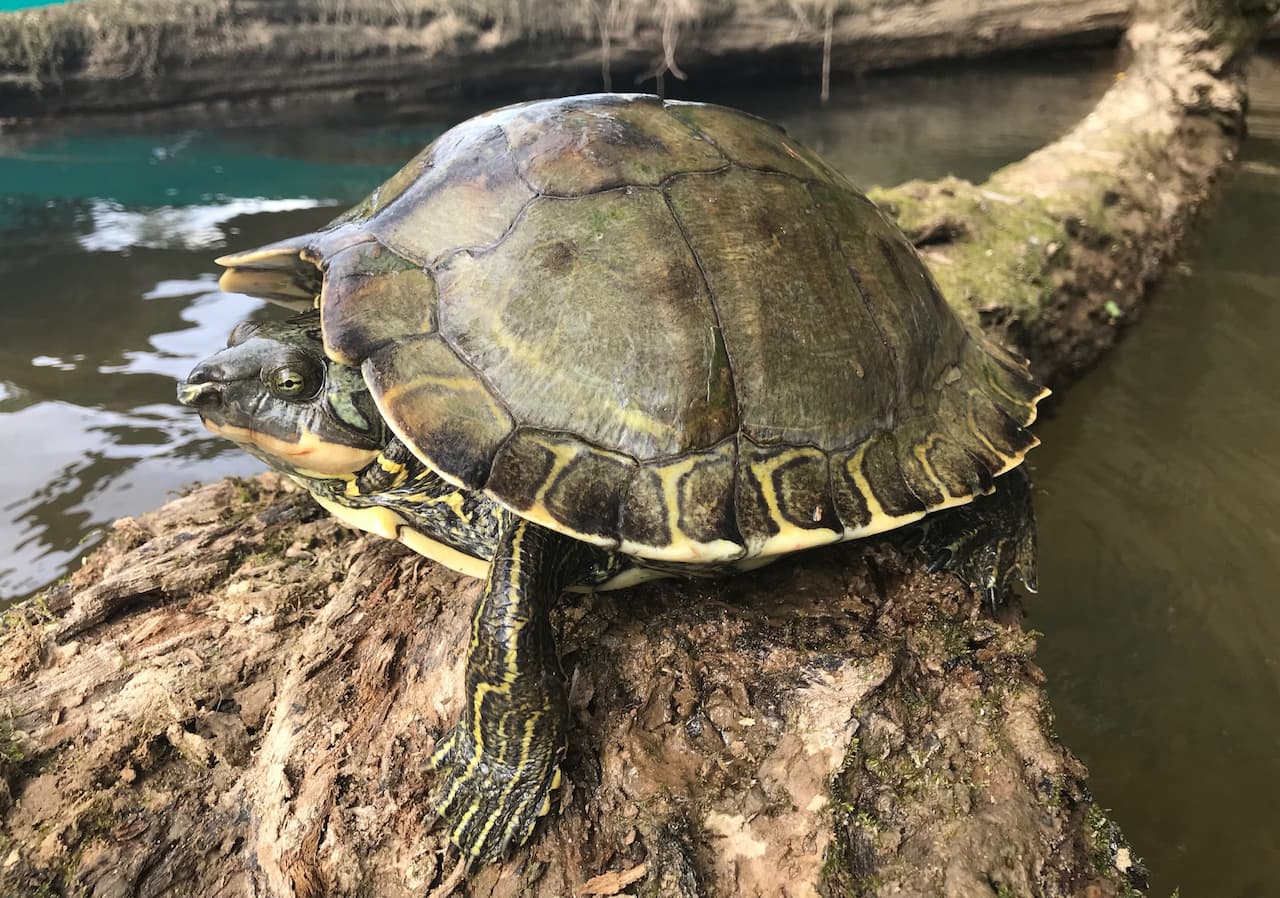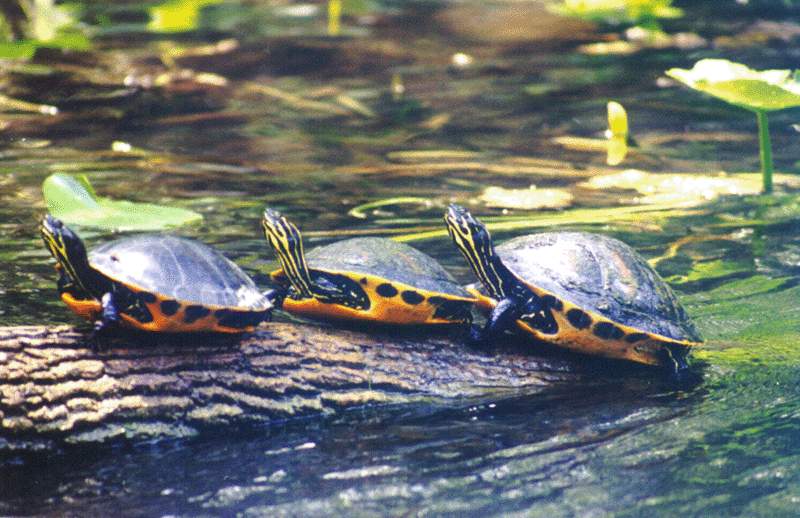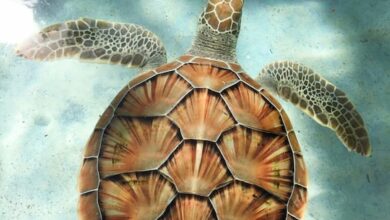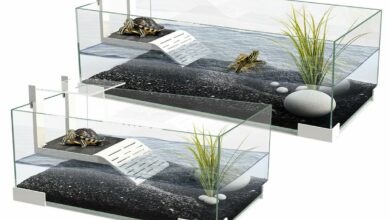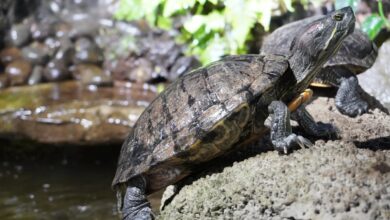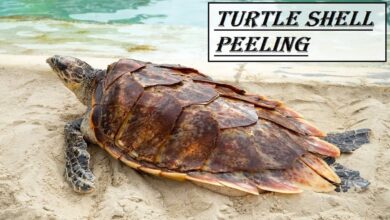Map Turtles
Map Turtles And Looking After Them
Graptemys, more commonly known as map turtles, is a genus that encompasses a wide range of freshwater turtle species. With 14 recognized species in this genus, these turtles have earned their reputation for their striking physical attributes. Map turtles vary in size from small to medium. It’s interesting to note a significant size disparity between the genders. Some female map turtles can even reach a size that is twice as long and weigh up to ten times more than the males. This significant sexual dimorphism is a defining feature of this genus.
The appeal of the map turtle extends beyond just its physical characteristics. Over the years, enthusiasts in the turtle-keeping hobby have developed a special fondness for these creatures. Their shy nature contrasts with their stunning visual appearance. In their native habitats, many of these species are considered rare and tend to be elusive. But when in captivity, they become lively swimmers and frequently bask, though they remain alert even in such relaxed moments. Their exquisite patterns further accentuate their beauty, drawing interest from potential keepers.
About The Map Turtle
Northern Map Turtles are the most common and widespread species of map turtles. Females’ carapaces can reach a length of up to 27 cm (10,5 in). Males are typically shorter than 16 cm (6.25 in). The females are larger and have a larger jaw, but the difference isn’t as great as in other turtle species. The carapace of the olive-green turtle is covered with a complex system of yellow lines, which resembles a topographical chart. The patterning can be hidden by the dark pigmentation of females, or algae. The skin of the northern map turtle is olive-brown to dark brown with yellow or greenish markings. The midline of the carapace is a distinct keel that is shallow, but not pronounced. It lacks spines or knobs. The postorbital blotch of these turtles is always a triangle-shaped blotch. The turtles also have a yellow j-shaped line that is curved upwards as it approaches the head.
Choosing and Buying
For those residing in the US, the map turtles are a popular choice. Their price is usually influenced by several factors. An individual turtle’s age, health status, and even the breeder’s reputation play a role in determining its cost. The cost might be between $20 to $100.
First and foremost, ensure you physically inspect the turtle. Be on the lookout for any irregularities, such as skin that appears flaky or irritated. The turtle’s shell and head shouldn’t have any abnormal bumps, and its eyes should be clear without any cloudiness. Purchasing from a well-known breeder can make a significant difference in ensuring you get a healthy turtle. Always prioritize a turtle that has a verified medical health record, ensuring that you’re bringing home a healthy companion.
How To Care For Them
Handling
Map turtles, as enchanting as they are to observe, are extremely apprehensive and often become distressed when handled excessively. They possess a naturally skittish disposition, and undue handling not only heightens their stress levels but may also lead to adverse health repercussions in the long run.
Given this sensitivity, it’s imperative that they are only picked up when it is absolutely essential. A good example of such a situation is when their tank requires cleaning. If you must handle them, ensure you do so with the utmost care. Adopt a gentle and slow approach to reduce their anxiety. Use both hands and gently cradle the underside of the turtle’s shell to lift it. This method reduces the risk of harm and discomfort.
When undertaking tasks like tank cleaning, it’s best practice to transfer your map turtles to a secondary container or a smaller tank temporarily. Refrain from letting them roam your home. Vast spaces they’re not accustomed to, devoid of their familiar hiding places, can induce significant stress.
Common Health Issues
Regrettably, map turtles, especially when in captivity, are prone to certain shell issues. The absence of natural sunlight and supplemental UVB can set the stage for fungal infections. These infections often manifest as white or gray patches, which, if not treated timely, can spread across the entirety of their carapace. Thankfully, treatments using Acriflavine, coupled with exposure to direct sunlight, have been effective in halting the spread of this fungus.
It’s worth noting the importance of maintaining an oxygen-rich environment within the map turtle’s enclosure. This can be achieved by introducing an abundance of aquatic plants and implementing an oversized filtration system. By ensuring the oxygen levels remain high and pH levels stay optimal for the species, you can ward off many of the usual problems encountered by those who care for map turtles.
Appearance and Behavior
The Northern map turtle, also colloquially referred to as the common map turtle, stands out as the most widespread and populous of all map turtle species. Their carapace, an earthy shade of olive green, is adorned with a delicate maze of pale yellow lines reminiscent of a topographical map. In females or algae-laden individuals, these markings might be less pronounced. Their skin, varying from olive to a deep brown, is streaked with yellowish or greenish patterns. Their carapace, while featuring a midline keel, lacks the pronounced spines or knobs that some other species might have. A distinct feature is a triangular blotch postorbital, with rounded points. A conspicuous j-shaped yellow line decorates the underside of their neck, arching upwards as it approaches the head.
Upon hatching, these turtles instinctively head downstream in search of suitable summer territory. Adult turtles are diurnal creatures, favoring meals of snails, mollusks, crayfish, freshwater mussels, and aquatic insects, primarily during the early hours and late afternoons. Their intake of vegetation is minimal and usually accidental. During downtime, these turtles often indulge in basking. Throughout late spring and summer, Northern map turtles display annual migratory behaviors. Such patterns are particularly evident in males as they venture to places distant from their wintering areas. Wintertime sees them hibernating in deeper, languid parts of rivers and water impoundments, where they opt to stay exposed instead of burying themselves in mud. They aren’t free from threats, as their nests become targets for raccoons, skunks, foxes, and river otters.
Size and Lifespan
When looking at map turtles, there’s a noticeable size difference between the genders. Females are often much larger, with their shells reaching lengths of up to 10.5 in. Males, however, are typically smaller, usually not growing longer than 6.2 in. The distinct enlargement of the female’s jaw, which gives them a slightly unique appearance. However, when comparing the size difference between males and females within the map turtle species, the disparity isn’t as stark as seen in other map turtle species.
The lifespan of map turtles, on average, spans 15 to 20 years, a duration that offers owners ample time to bond and interact with these mesmerizing creatures. Highlighting the potential longevity of these species, a remarkable instance was observed at the National Zoo in Washington, D.C., where a Barbour’s map turtle lived for over 31 years in captivity.
Temperament
The IUCN (International Union for Conservation of Nature) classifies Northern map turtles as a species of “least concern.” This implies that their existence isn’t immediately threatened, but it’s important to note certain changes in their habitats. Regions that have seen a decline in water quality, and consequently a reduction in freshwater mollusk populations, have likely seen reductions in Northern map turtle numbers. Interestingly, the introduction of invasive species like the zebra mussels might have inadvertently benefited the Northern map turtles, providing them with additional food sources. As of now, their population seems to be in a stable state.
Behaviorally, the common map turtle exhibits a period of dormancy from November to the early days of April. This hibernation-like state primarily sees them submerged underwater, often nestling beneath logs or resting in the muddy lakebed. Some might even take refuge in burrows. An intriguing observation, as documented by Harding in 1997, is their propensity to switch locations even during this dormant winter period. On sunny days, they are fond of basking, often congregating in groups to soak up the warmth, as noted by Kirkpatrick in 1999. Their diurnal nature ensures activity both during the day and nighttime. These turtles are cautious creatures, tending to retreat into the water at the faintest hint of danger. When it comes to mating rituals, it’s the males who make the first move, often tapping their elongated claws on the female’s frontal region. Yet, there’s still a lot to be uncovered about the intricate details of their courtship behavior.
Housing Map Turtles
Enclosure Size
Map turtles, while bearing resemblances to Sliders and Painted turtles, have distinct care requirements stemming from their natural habitat: clear, fast-flowing rivers. Consequently, in captivity, they need a well-oxygenated and filtered environment. For young turtles, a 20-gallon long aquarium may suffice for a pair or trio, but maintaining water purity is paramount. Employing an external filter and introducing a small airstone for extra oxygen and turbulence can mimic their natural habitat. Map turtles are also enthusiastic baskers, making it crucial to integrate elements like driftwood for them to lounge on and absorb both heat and UVB.
For those considering outdoor ponds, Map turtles flourish in these settings. Given their penchant for basking, the outdoor setup should incorporate expansive basking areas. While northern species can hibernate, planning for their hibernation is essential. Conversely, southern species, during colder spells (temperatures dipping below 45° to 50° F), need indoor shelter but should still experience a cooler period to promote breeding behavior when spring returns.
To optimize an outdoor pond, it’s wise to avoid overstocking it with Map turtles. Introducing aquatic plants, especially floaters like water lettuce, water hyacinth, and duckweed, can maintain a healthy ecosystem and oxygenate the water.
Lighting
Lighting in a Map turtle’s enclosure is pivotal for their well-being. Beyond visibility, the correct lighting regimen ensures their health. Enclosures should ideally have:
Heating bulb: This replicates the warmth of the sun and regulates the enclosure’s temperature.
UV bulb: Emitting essential UVA and UVB rays, this bulb promotes healthy metabolism and calcium absorption for shell strength.
Viewing light (optional): For observing the turtles without altering their environment.
Night bulb (optional): Helps in maintaining a minimal temperature during colder nights.
Temperature and Humidity
Ensuring the optimal temperature for Map turtles is crucial. Even minor deviations can pose significant health threats. Below is a guideline for their temperature requirements:
Average air temperature: 75°F to 80°F
Average basking temperature:
Adults: 85°F to 110°F
Hatchlings: 85°F to 100°F
However, remember that these temperatures might differ slightly based on the turtle’s species.
The location’s inherent temperature determines the heater’s strength. For instance, in colder regions, a 150-watt heater might be essential for a 40-gallon tank. Conversely, in warmer climates, a less potent heater might suffice.
Substrate and Decoration
Creating a naturalistic and comfortable environment is vital when setting up a habitat for your map turtle. Aesthetic and functional elements can work in tandem to make the enclosure both visually appealing and safe for the turtle. Consider integrating small logs and artificial plants to fashion cozy hideouts for your turtle.
While decoration can enhance the habitat’s look, it’s essential to ensure safety. Stay away from items with sharp edges or those that might restrict swimming space. A popular choice among turtle enthusiasts is to lay a substrate on the tank’s bottom and intersperse it with small plants. Once you’ve placed all decorations thoughtfully, fill the tank with clean water, ensuring the depth is appropriate for your map turtle’s size and age. With everything set, introduce your turtle to its revamped home.
For those looking to foster a community environment, certain species can coexist with map turtles in the same enclosure, given that space and resources are ample.
Food and Water
Map turtles are aquatic dwellers that prefer their meals submerged. Adopt a feeding schedule of about four to five times weekly. To ensure balanced nutrition and prevent overfeeding, provide a varied diet that the turtle can consume within a span of two to three minutes. Morning or afternoon feedings align with their peak activity periods.
Their omnivorous palate in captivity should echo their natural dietary preferences, encompassing a mix of plant matter and animal protein. Some staples include dark greens such as dandelion leaves, romaine lettuce, and parsley, combined with aquatic turtle pellets, tiny insects, crustaceans, and freeze-dried shrimp or fish chunks. Due to their more robust jaws, female turtles can manage larger prey like small snails. In contrast, males are better suited to smaller fare like diced crickets, mealworms, and bite-sized fish pieces. Young hatchlings should receive daily meals, predominantly comprising turtle pellets and greens, for the initial six months.
Breeding
Breeding seasons span spring and autumn, with a majority of the nesting occurring between late May to mid-July. While eggs hatch by the close of summer, hatchlings often opt to remain within until winter concludes. Preferred nesting sites are sunlit, sandy expanses like beaches or sandbanks, located in close proximity to water. The entire egg-laying procedure is prolonged, usually commencing at dusk and extending till dawn.
On average, a female lays about 10-12 eggs per clutch and may produce 2 or 3 clutches annually. Incubation, lasting around 75 days, plays a role in sex determination, with higher temperatures yielding females and lower ones resulting in males. Maturity is attained faster by males, typically between 4-6 years, whereas females might need over a decade.
Cleaning
Maintaining a clean habitat is crucial for the well-being of map turtles. These turtles generate substantial waste, which can elevate the tank’s ammonia and nitrate concentrations. This not only hastens algae proliferation, making cleaning arduous but also poses health risks to the turtle.
To ensure pristine water quality, invest in a potent filter. With efficient filtration, water changes can be limited to bi-weekly intervals. Nonetheless, comprehensive cleaning of the entire enclosure should be scheduled every three months. This thorough clean-up prevents the accumulation of waste and ensures a healthy environment for your pet.
Habitat and Distribution
Map turtles are a widely distributed species that can be found as far north as Quebec, and as far south Alabama and Arkansas. They live in the drainages of the northeast that drain into Atlantic Ocean. They are also found in several drainages in the southeast that empty into Gulf of Mexico. However, they do not inhabit much of the Mississippi River and adjacent waterways. This species prefers large bodies of water such as rivers, lakes, and large streams to creeks and ponds. Although they are cautious baskers, they require a lot of basking areas. Northern map turtles prefer clear, flowing water habitats with gravel substrates.
Where They Originate From
Among the Graptemys, the northern map turtle has a considerably wide distribution. It can be found as far up as Quebec, stretching down southward to areas like Alabama and Arkansas. Their preferred habitats include drainages that lead to the Atlantic Ocean, with a few of them also present in drainages connected to the Gulf of Mexico. Contrary to what some might believe, the northern map turtle doesn’t populate most of the Mississippi River and its nearby water bodies.
Their habitat preference is inclined towards larger water bodies. This includes expansive rivers, vast streams, and sprawling lakes. You would rarely find them in smaller creeks or ponds. One of their primary needs is a good basking site, but they’re also known to be cautious while basking. A characteristic trait of the northern map turtle is its affinity for clear waters with a current, especially if the water bed is gravelly.
Reproduction & Development
Breeding takes place in the spring as well as fall. The majority of nesting is likely to take place between late May and mid-July. Hatchlings often delay their emergence until winter. The eggs hatch late in the summer. Nests are usually built on sandy beaches, sandbars or open areas rather than in wooded areas. The nests are always near the water. Laying eggs can take several hours. It usually begins at night and continues until morning. The average clutch size is 10-12 eggs, with females producing two or three clutches per year. As with other turtle species, the incubation period, which lasts 75 days, determines the sexe. The warmer temperatures result in females, while the cooler temperatures produce males. Males reach sexual maturity in 4-6 years while females can take up to 10 years.
Habits
Hatchlings move quickly downstream to find a summer home range. Adults spend most of their time active during the daylight hours, eating snails, other mollusks such as crayfish and freshwater mussels. They also feed on aquatic insects and crayfish in the early morning and late afternoon. They do not consume much vegetation. What they do eat is consumed incidentally. They can often be seen basking when not feeding. The northern map turtles have annual patterns of movement in late spring and the summer. Males are the most likely to exhibit these patterns, as they move away from their wintering grounds. Map turtles hibernate mainly in slow-moving, deep riverine pools or impoundments during the winter. The turtles do not bury themselves in mud, but rather remain on the surface. Raccoons and skunks are common predators. River otters and foxes also prey on nestlings. Raccoons also feed on adults. They are followed by skunks and coyotes.
Conservation
The IUCN lists northern map turtles as species of low concern. The IUCN has listed the northern map turtle as a species of least concern. The introduction of invasive species such as zebra mussels may have helped the species to stabilize.
Conclusion
In conclusion, setting up and maintaining a suitable environment for map turtles requires attention to various factors. From the appropriate size and structure of their enclosure, the need for proper lighting and heating, to selecting safe substrates and decorations, and ensuring a balanced diet – every detail matters. Additionally, understanding their breeding habits and ensuring regular cleaning routines can contribute to the turtles’ longevity and well-being. Just like any other pet, map turtles thrive when provided with the right care and environment.

